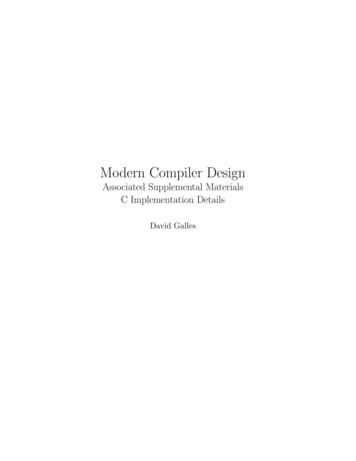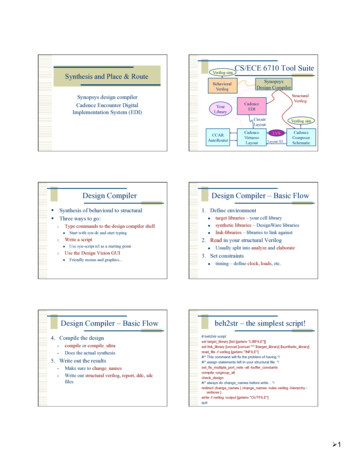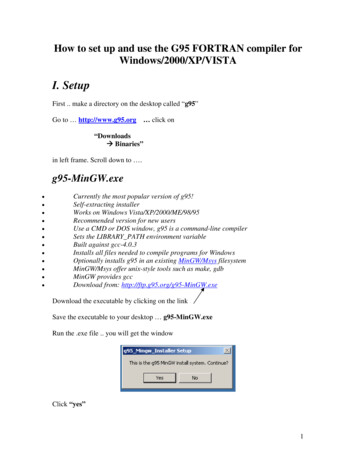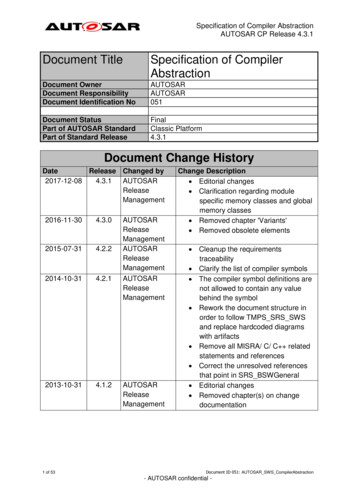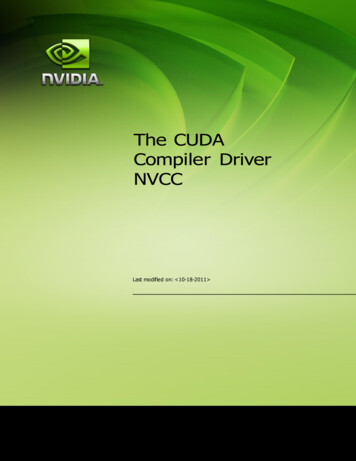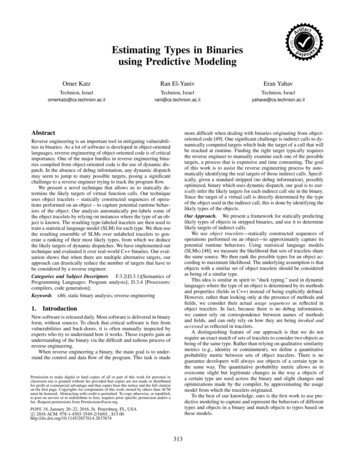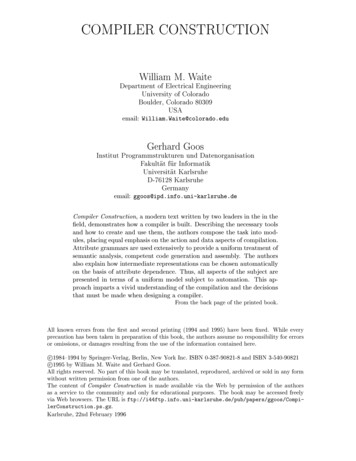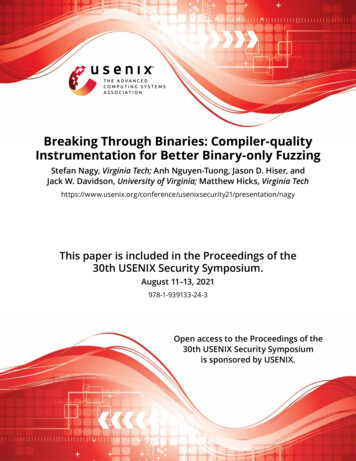
Transcription
Breaking Through Binaries: Compiler-qualityInstrumentation for Better Binary-only FuzzingStefan Nagy, Virginia Tech; Anh Nguyen-Tuong, Jason D. Hiser, andJack W. Davidson, University of Virginia; Matthew Hicks, Virginia ty21/presentation/nagyThis paper is included in the Proceedings of the30th USENIX Security Symposium.August 11–13, 2021978-1-939133-24-3Open access to the Proceedings of the30th USENIX Security Symposiumis sponsored by USENIX.
Breaking Through Binaries: Compiler-quality Instrumentationfor Better Binary-only FuzzingStefan NagyVirginia TechAnh Nguyen-Tuong, Jason D. Hiser, Jack W. DavidsonUniversity of VirginiaMatthew HicksVirginia Techsnagy2@vt.edu{nguyen, hiser, uided fuzzing is one of the most effective software security testing techniques. Fuzzing takes on one oftwo forms: compiler-based or binary-only, depending onthe availability of source code. While the fuzzing community has improved compiler-based fuzzing with performanceand feedback-enhancing program transformations, binaryonly fuzzing lags behind due to the semantic and performance limitations of instrumenting code at the binary level.Many fuzzing use cases are binary-only (i.e., closed source).Thus, applying fuzzing-enhancing program transformationsto binary-only fuzzing—without sacrificing performance—remains a compelling challenge.This paper examines the properties required to achievecompiler-quality binary-only fuzzing instrumentation. Basedon our findings, we design Z AFL: a platform for applyingfuzzing-enhancing program transformations to binary-onlytargets—maintaining compiler-level performance. We showcase Z AFL’s capabilities in an implementation for the popularfuzzer AFL, including five compiler-style fuzzing-enhancingtransformations, and evaluate it against the leading binaryonly fuzzing instrumenters AFL-QEMU and AFL-Dyninst.Across LAVA-M and real-world targets, Z AFL improves crashfinding by 26–96% and 37–131%; and throughput by 48–78% and 159–203% compared to AFL-Dyninst and AFLQEMU, respectively—while maintaining compiler-level ofoverhead of 27%. We also show that Z AFL supports realworld open- and closed-source software of varying size (10K–100MB), complexity (100–1M basic blocks), platform (Linuxand Windows), and format (e.g., stripped and PIC).1IntroductionSoftware vulnerabilities represent a persistent threat to cybersecurity. Identifying these bugs in both modern and legacysoftware is a tedious task; manual analysis is unrealistic, andheavyweight program analysis techniques like symbolic execution are unscalable due to the sheer size of real-worldapplications. Instead, developers and bug-hunters alike havelargely adopted a software testing strategy known as fuzzing.Fuzzing consists of mutationally generating massiveamounts of test cases and observing their effects on the targetprogram, with the end goal of identifying those triggeringUSENIX Associationbugs. The most successful of these approaches is coverageguided grey-box fuzzing, which adds a feedback loop to keepand mutate only the few test cases reaching new code coverage; the intuition being that exhaustively exploring target codereveals more bugs. Coverage is collected via instrumentationinserted in the target program’s basic blocks. Widely successful coverage-guided grey-box fuzzers include AFL [93],libFuzzer [70], and honggFuzz [75].Most modern fuzzers require access to the target’s sourcecode, embracing compiler instrumentation’s low overheadfor high fuzzing throughput [70, 75, 93] and increased crashfinding. State-of-the-art fuzzers further use compilers to apply fuzzing-enhancing program transformation that improvestarget speed [32, 47], makes code easier-to-penetrate [1], ortracks interesting behavior [18]. Yet, compiler instrumentation is impossible on closed-source targets (e.g., proprietary orcommercial software). In such instances fuzzers are restrictedto binary instrumentation (e.g., Dyninst [64], PIN [56], andQEMU [8]). But while binary instrumentation succeeds inmany non-fuzzing domains (e.g., program analysis, emulation, and profiling), available options for binary-only fuzzingare simply unable to uphold both the speed and transformation of their compiler counterparts—limiting fuzzing effectiveness. Despite advances in general-purpose binary instrumentation [9, 41, 46, 86, 87], it remains an open questionwhether compiler-quality instrumentation capabilities andperformance are within reach for binary-only fuzzing.To address this challenge we scrutinize the field of binaryinstrumentation, identifying key characteristics for achievingperformant and general-purpose binary-only fuzzing instrumentation. We apply this standard in designing Z AFL: aninstrumentation platform bringing compiler-quality capabilities and speed to x86-64 binary-only fuzzing. We demonstrate how Z AFL facilitates powerful fuzzing enhancementswith a suite of five transformations, ported from compilerbased fuzzing contexts. We show how Z AFL’s capabilitiesimprove binary-only fuzzing bug-finding: among evaluationson the LAVA-M corpus and eight real-world binaries, Z AFLfinds an average of 26–96% more unique crashes than thestatic rewriter AFL-Dyninst; and 37–131% more than thedynamic translator AFL-QEMU. We further show that Z AFLachieves compiler-quality overhead of 27% and increasesfuzzing throughput by 48–78% and 131–203% over AFLDyninst and AFL-QEMU, respectively. Lastly, we show that30th USENIX Security Symposium1683
Z AFL scales to real-world software—successfully instrumenting 56 binaries of varying type (33 open- and 23 closedsource), size (10K–100MB), complexity (100–1,000,000 basic blocks), and platform (30 Linux and 12 Windows).In summary, this paper contributes the following: We examine the challenges of achieving compiler-qualityinstrumentation in binary-only fuzzing, developing a criteria for success, and highlighting where popular binary-onlyinstrumenters fit with respect to our criteria. We apply this criteria in designing Z AFL: a platformfor state-of-the-art compiler-quality instrumentation—andspeed—in binary-only fuzzing. Z AFL’s architectural focuson fine-grained instrumentation facilitates complex fuzzingenhancing transformations in a performant manner. We show that it is possible to achieve fuzzing-enhancingprogram transformation in a performant manner for binaryonly contexts by implementing five of such transformationsderived from existing compiler-based implementations inZ AFL, and evaluating runtime overhead. We demonstrate how Z AFL improves fuzzing effectiveness;on average Z AFL’s performant, fuzzing-enhancing programtransformations enable fuzzers to find more unique crashesthan the leading binary-only fuzzing instrumenters AFLDyninst and AFL-QEMU across both LAVA-M and realworld benchmarks. We show that Z AFL supports real-world binaries of varyingcharacteristics, size, complexity, and platform—even thosebinaries not supported by other instrumenters. We will open-source Z AFL and all benchmark corpora ckground on FuzzingCoverage-guided grey-box fuzzing remains one of the mostsuccessful software security auditing techniques. Fuzzers ofthis type iteratively mutate test cases to increase code coverage, using lightweight instrumentation to collect this coverageat runtime. This section details the fundamental componentsof coverage-guided grey-box fuzzing.2.1An Overview of FuzzingFuzzing is designed to root-out software vulnerabilities automatically. Given a target program and a set of seed test cases,a standard fuzzing cycle consists of (Figure 1):0. Instrumentation: modify target program as desired (e.g.,to track code coverage).1. Test Case Generation: select a seed and mutate it to generate a batch of candidate test cases.2. Execution Monitoring and Feedback Collection: runeach candidate test case and monitor the target program’sexecution, collecting feedback via instrumentation.3. Feedback Decision-making: keep only test cases with execution behavior matching some pre-specified constraint(s)168430th USENIX Security entedTarget2 Exec. Monitoring,Feedback Collection3FeedbackDecisionMaking1Test CaseGeneration4Figure 1: A high-level overview of the basic fuzzing workflow.(e.g., cover new code).4. Return to step 1.Though fuzzers vary by generation (i.e., mutation- [70, 75,93] or grammar-based [35,50,60]), execution monitoring (i.e.,white- [17,22,36], black- [60,63,83], or grey-box [70,75,93]),and feedback decision-making strategies (i.e., directed [13,33, 41, 89] or coverage-guided [14, 70, 75, 93]), we elide theirdifferentiation as they are outside the focus of this paper.2.2Coverage-guided Grey-box FuzzingBy far the most popular fuzzing technique is coverage-guidedgrey-box fuzzing (e.g., AFL [93], honggFuzz [75], and libFuzzer [70]). As the name implies, coverage-guided grey-boxfuzzers focus exclusively on test cases that increase codecoverage, with the aim of testing as much of a target program’s functionality as possible to find its deeply-rooted bugs.Its “grey-box” quality refers to a middle-ground betweenthe deep and shallow program analyses used by white- andblack-box fuzzers, respectively: lightweight instrumentationis used track test cases’ coverage of the target, which is thenpost-processed to verify if new code has been covered.Contingent on the ability to instrument a target programfrom source, fuzzing is divided into two distinct worlds:compiler-based and binary-only. Most modern fuzzers turnto compiler instrumentation as its low runtime overhead supports high fuzzing throughput. More recent state-of-the-artefforts leverage compilers’ ability to apply complex programtransformations. Researchers have shown that such transformations improve fuzzing effectiveness by enhancing performance [32,47] or introspection [1,18,31,51]. Most real-worldfuzzing is undertaken in the absence of target source (i.e.,binary-only). This restricts fuzzing to existing binary instrumenters which are unsupportive of compiler-quality transformation, facing prohibitively-high overhead—often as high as1000% for coverage tracing alone [62].3Compiler-based Fuzzing EnhancementsCoverage-guided fuzzing spans two distinct domains:compiler-based and binary-only, with both using programinstrumentation to track test case code coverage. Much offuzzing’s success is due to the high throughput made possibleby fast compiler instrumentation [79, 93]. Though advancedfuzzers introduce more heavyweight analyses [7, 18, 74, 92],USENIX Association
FocusCategoryEffect on ationDowngradingOverhead reduction from fewerblocks instrumentedOverhead reduction from lighterweight ra-coverageBehaviorIncremental coverage to guide codepenetrationAbility to consider finer-grained execution behaviorTable 1: Popular compiler-based fuzzing-enhancing program transformations,listed by category and effect.the core of these approaches remains the standard coverageguided fuzzing loop (Figure 1)—amounting to over 90%of their execution time [62]; recent feedback enhancements(e.g., context sensitivity) only increase the proportion of timespent tracing execution. Thus, our focus is performant fuzzingenhancing transformations in the absence of source code.State-of-the-art fuzzers leverage compiler instrumentation to add transformations that improve fuzzing performance and feedback (e.g., AFL [31], Angora [18], CollAFL [32], honggFuzz [75], INSTRIM [47], libFuzzer [70]).Performance-enhancing transformation helps alleviate theruntime cost of coverage tracing and other feedback sources.Feedback-enhancing transformations reveal finer-grained program progress, beyond traditional code coverage metrics. Webroadly examine popular fuzzers and identify four categoriesof fuzzing-enhancing transformation that target the corecoverage-guided loop (Table 1): (1) instrumentation pruning, (2) instrumentation downgrading, (3) sub-instructionprofiling, and (4) extra-coverage behavior tracking. Belowwe detail each transformation.3.1Instrumentation PruningGraph reducibility techniques [42, 77] are used in fuzzingto elide instrumenting some target basic blocks, thus lowering overall runtime overhead. AFL’s [93] compiler instrumentation permits a “ratio”: 100 instruments all blocks; 0only function entries; and values in between form a probability to arbitrarily skip blocks. Clearly, culling random blocksrisks coverage blind-spots. More rigorous CFG-aware analyses [31, 47] prune blocks implicitly covered by others: formally, for N blocks and M unique paths over N, it is possibleto select a subset N 0 N such that the M 0 unique paths over N 0equals M. INSTRIM [47] only instruments blocks targeted bybackward edges and tracks loops either by entry or pre-entryblocks (the latter forgoing loop iteration tracking).3.2Instrumentation DowngradingThe majority of today’s fuzzers track coverage in the form ofedges (i.e., branches between basic blocks). Edges are typically recorded as hashes of their start and end blocks (computed in the body of the end block’s instrumentation), as popularized by the fuzzer AFL [93]. Edge hashing requires severalinstructions (two index fetches, a hash, array update, and anXOR); but given that blocks themselves are small, maintain-USENIX Associationing speed requires inserting as few instructions as necessary.CollAFL [32]’s compiler instrumentation optimizes singlepredecessor blocks by downgrading them to fewer-instructionblock coverage (i.e., cov(A B) cov(B)).3.3Sub-instruction ProfilingFuzzers struggle to penetrate code guarded by complex predicates like “magic bytes” [68], nested checksums [7], andswitch cases [1]. Most fuzzers track edge/block coverage andhence are oblivious to “incremental” predicate progress. Recent compiler-based efforts apply sub-instruction profiling—decomposing multi-byte conditionals into single-byte comparisons (e.g., CmpCov [51], honggFuzz [75], laf-Intel [1]).Such splitting of roadblocks into smaller, simpler problemsfacilitates greater fuzzing code coverage.3.4Extra-coverage Behavior TrackingAn area of current research in fuzzing is the inclusion of execution behavior beyond traditional code coverage. Althoughwe foresee future work considering metrics such as register ormemory usage, the existing body of work on extra-coveragebehavior tracking focuses on context sensitivity. Contextsensitive coverage tracks edges along with their precedingcalling context. For example, given two paths over the sameset of edges, A B C and B A C, context-insensitivecoverage misses the second path as it offers no new edges;however context-sensitive coverage reveals two distinct calls:B C and A C. Several LLVM implementations exist forboth function- and callsite-level context sensitivity [18, 31].4Binary-only Fuzzing: the Bad & the UglyProgram transformation has become ubiquitous in compilerbased fuzzers (e.g., AFL [31], CollAFL [32], laf-Intel [1]),and for good reason: it makes fuzzing significantly morepowerful. Despite these advantages there is no platform thatadapts such transformation to binaries in an effective manner—severely impeding efforts to fuzz closed-source software.This section examines existing binary instrumenters andtheir limitations that prevent them from attaining effectivebinary-only fuzzing instrumentation. We follow this exploration with an identification of the key instrumenter design attributes necessary to support compiler-quality fuzzingenhancing program transformation and speed.4.1Limitations of Existing PlatformsCoverage-guided fuzzers trace test case code coverage via fastcompiler instrumentation; and state-of-the-art efforts furtherleverage compilers to apply fuzzing-enhancing program transformation. In binary-only fuzzing, code coverage is tracedby one of three mechanisms: (1) hardware-assisted tracing,30th USENIX Security Symposium1685
8,19,31,32,47, 70, 75, 93]18–32%Intel PTDynamoRIOPINQEMUDyninstRetroWrite[7, 11, 20, 37, 75][37, 43, 73][45, 49, 63, 68, 92][23, 31, 91, 93][44, 55, 62, 76][26]19–48% 1,000% 10,000% 600% ramp.X7XXX7XPIC & PDCN/AXXXXX7Supported ProgramsC & C strippedXXXXXX7PE32 N/AN/AXXXX77XXXX77Table 2: A qualitative comparison of the leading coverage-tracing methodologies currently used in binary-only coverage-guided fuzzing, alongside compilerinstrumentation (LLVM). No existing approaches are able to support compiler-quality transformation at compiler-level speed and generalizability.(2) dynamic binary translation, or (3) static binary rewriting.Below we briefly detail each, and weigh their implicationswith respect to supporting the extension of compiler-qualitytransformation to binary-only fuzzing. Hardware-assisted Tracing. Newer processors are offering mechanisms that facilitate binary code coverage (e.g.,Intel PT [48]). Fuzzing implementations are burdened bythe need for costly trace post-processing, which reportedlyincurs overheads as high as 50% over compilers [7,20]; butdespite some optimistic performance improvements [37],hardware-assisted tracing currently remains incapable ofmodifying programs—and hence fails to support fuzzingenhancing program transformation. Dynamic Binary Translators. Dynamic translators applycoverage-tracing on-the-fly as the target is executing (e.g.,DynamoRIO [43], PIN [56], and QEMU [8]). Translatorsgenerally support many architectures and binary characteristics; and offer deep introspection that simplifies analysis andtransformation [31, 93]. However, existing dynamic translators attain the worst-known fuzzing performance: recentwork shows AFL-QEMU’s average overhead is well over600% [62], and AFL-DynamoRIO [43] and AFL-PIN [45]report overheads of up to 10x and 100x higher, respectively. Static Binary Rewriters. Static rewriting improves performance by modifying binaries prior to runtime (e.g.,Dyninst [44]). Unfortunately, static rewriting options forbinary-only fuzzing are limited. AFL-Dyninst is the mostpopular, but sees prohibitively-high fuzzing overheadsof over 500% [62] and is restricted to Linux programs.RetroWrite suggests reassembleable-assembly is more performant and viable, but it relies on AFL’s assembly-time instrumentation which is both unsupportive of transformationand reportedly 10–100% slower than compile-time instrumentation [93]; and moreover, it does not overcome the generalizability challenges of prior attempts at reassembleableassembly (e.g., Uroboros [87], Ramblr [86]), and is hencelimited to position-independent Linux C programs. Neitherscale well to stripped binaries.As summarized in Table 2, the prevailing binary-onlyfuzzing coverage-tracing approaches are limited in achievingcompiler-quality fuzzing instrumentation. Hardware-assisted168630th USENIX Security Symposiumtracing (Intel PT) is incompatible with program instrumentation/transformation and adds post-processing overhead.Dynamic translators (DynamoRIO, PIN, and QEMU) allface orders-of-magnitude worse overheads. Static rewriters(Dyninst and RetroWrite) fail to uphold both performance andtransformation and are unsupportive of Windows software(the most popular being PE32 ), common binary characteristics (e.g., position-dependent code), or the simplest obfuscation techniques (i.e., stripped binaries).These limitations make fuzzing-enhancing transformationsscarce in binary-only fuzzing. To our knowledge the onlytwo such implementations exist atop of AFL-Dyninst (instruction pruning [44]) and AFL-PIN (context sensitivity [92])—both suffering from the central flaw that any of their potential benefits are outweighed by the steep overheads of theirrespective binary instrumenters (over 500% and 10,000%,respectively [45, 62]).Impetus: Current binary instrumenters are fundamentally illequipped to support compiler-quality fuzzing instrumentation.We envision a world where binary-only and compiler-basedfuzzing are not segregated by capabilities; thus we design abinary-only fuzzing instrumentation platform capable of performant compiler-quality transformation.4.2Fundamental Design ConsiderationsOur analysis of how compilers support performant programtransformations reveals four critical design decisions: (1)rewriting versus translation, (2) inlining versus trampolining, (3) register allocation, and (4) real-world scalability. Below we discuss the significance of each, and builda criteria of the instrumenter characteristics best-suited tocompiler-quality instrumentation. Consideration 1: Rewriting versus Translation. Dynamic translation processes a target binary’s source instruction stream as it is executed, generally by means of emulation [8]. Unfortunately, this requires heavy-lifting tointerpret target instructions to the host architecture; and incurs significant runtime overhead, as evidenced by the poorperformance of AFL-DynamoRIO/PIN/QEMU [43, 45, 93].While translation does facilitate transformations like subinstruction profiling [31], static binary rewriting is a moreUSENIX Association
viable approach for fuzzing due to its significantly loweroverhead. Like compilers, static binary rewriting performsall analyses (e.g., control-flow recovery, code/data disambiguation, instrumentation) prior to target execution, avoiding the costly runtime effort of dynamic translation. Thus,static rewriting is the most compatible with achievingcompiler-quality speed in binary-only fuzzing.position-independent (i.e., relocatable) code and neglectthe bulk of software that remains position-dependent [26];many presume access to debugging symbols (i.e., nonstripped) but this seldom holds true when fuzzing proprietary software [44]; and most are only Linux-compatible,leaving some of the world’s most popular commodity software (Windows 64-bit PE32 ) unsupported [26, 44, 86, 87].A compiler-quality binary-only fuzzing instrumenter musttherefore support these garden-variety closed-source binarycharacteristics and formats.Criterion 1: Instrumentation added via static rewriting. Consideration 2: Inlining versus Trampolining. A second concern is how instrumentation code (e.g., coveragetracing) is invoked. Instrumenters generally adopt one oftwo techniques: trampolining or inlining. Trampoliningrefers to invocation via jumping to a separate payload function containing the instrumentation. This requires two transfers: one to the payload, and another back to the callee.However, the total instructions needed to accommodate thisredirection is significant relative to a basic block’s size;and their overhead accumulation quickly becomes problematic for fuzzing. Modern compilers inline, injectinginstrumentation directly within target basic blocks. Inliningoffers the least-invasive invocation as instrumentation islaunched via contiguous instruction execution rather thanthrough redirection. We thus believe that inlining is essential to minimize fuzzing instrumentation’s runtime overheadand achieve compiler-quality speed in binary-only fuzzing.Criterion 2: Instrumentation is invoked via inlining. Consideration 3: Register Allocation. Memory access isa persistent bottleneck to performance. On architectureswith a finite set of CPU registers (e.g., x86), generating fastcode necessitates meticulous register allocation to avoidclobbering occupied registers. Condition code registers(e.g., x86’s eflags) are particularly critical as it is commonto modify them; but saving/restoring them to their original state requires pushing to the stack and is thus 10xslower than for other registers. Compilers track registerliveness to avoid saving/restoring dead (untouched) condition code registers as much as possible. Smart registerallocation is thus imperative to attaining compiler-qualitybinary instrumentation speed.Criterion 3: Must facilitate register liveness tracking. Consideration 4: Real-world Scalability. Modern compilers support a variety of compiled languages, binary characteristics, and platforms. While dynamic translators (e.g.,DynamoRIO, QEMU, PIN) are comparably flexible because of their reliance on emulation techniques, existingstatic rewriters have proven far less reliable: some requirebinaries be written in C despite the fact that developers areincreasingly turning to C [26,86,87]. others apply to onlyUSENIX AssociationCriterion 4: Support common binary formats and platforms.While binary instrumenters have properties useful to manynon-fuzzing domains (e.g., analysis, emulation, and profiling),attaining compiler-quality fuzzing instrumentation hingeson satisfying four core design criteria: (C1) static rewriting, (C2) inlining, (C3) register liveness, and (C4) broad binary support. Hardware-assisted tracing cannot modify programs and hence violates criteria (C1)–(C3). DynamoRIO,PIN, and QEMU adopt dynamic translation (C1) and thusincur orders-of-magnitude performance penalties—before applying any feedback-enhancing transformation. Dyninst andRetroWrite embrace static rewriting but both rely on costliertrampoline-based invocation (C2) and fail to support commodity binary formats and characteristics (C4); and moreover,Dyninst’s liveness-aware instrumentation failed on our evaluation benchmarks (C3). Thus, compiler-quality instrumentationin a binary-only context demands a new approach that satisfiesall four criteria.5The Z AFL PlatformFuzzing effectiveness severely declines on closed-source targets. Recent efforts capitalize on compiler instrumentationto apply state-of-the-art fuzzing-enhancing program transformations; however, current binary-only fuzzing instrumentersare ineffective at this. As practitioners are often restricted tobinary-only fuzzing for proprietary or commercial software,any hope of advancing binary-only fuzzing beseeches effortsto bridge the gap between source-available and binary-onlyfuzzing instrumentation.To combat this disparity we introduce Z AFL: a compilerquality instrumenter for x86-64 binary fuzzing. Z AFL extends the rich capabilities of compiler-style instrumentation—with compiler-level throughput—to closed-source fuzzing targets of any size and complexity. Inspired by recent compilerbased fuzzing advancements (§ 3), Z AFL streamlines instrumentation through four extensible phases, facilitating intuitive implementation and layering of state-of-the-art fuzzingenhancing program transformations. Below we detail Z AFL’sinternal architecture and guiding design principles.30th USENIX Security Symposium1687
Static Rewriting ComponentThe ZAFL PlatformZAX Transform & Inst. PhasesP1: Control-Flow Opts.OriginalBinaryP2: Control-Flow AnalysisBinary Rewriterr1; r2; r3Build BinaryRepresentationr2; r3r0; r1; r2Original IRSpecify Optimizations Optimized Control-flow GraphIR Data StructP4: Inst. ApplicationSpecify Analyses Extract Meta-characteristicsP3: Inst. Point SelectionModified IRReconstituteOutput Binaryr1; r2; r3r2; r3r0; r1; r2OutputBinaryEdge Cov.Block Cov.Selection, Liveness, Inst. Templates Apply InstrumentationMeta-characteristic Data Location SelectionFigure 2: A high-level depiction of the Z AFL platform architecture and its four Z AX transformation and instrumentation phases.5.1Design OverviewAs shown in Figure 2, Z AFL consists of two primary components (1) a static rewriting engine and (2) Z AX: our fourIR-modifying phases for integrating compiler-quality instrumentation and fuzzing enhancements. Given a target binary,Z AFL operates as follows:1. IR Extraction. From our (or any compatible) binaryrewriter, Z AFL requests an intermediate representation (IR)of the target binary.2. Z AX. The resulting IR is then passed to Z AX’s four transformation and instrumentation phases:P1: Optimization,P2: Analysis,P3: Point Selection, andP4: Application.3. Binary Reconstitution. After Z AX applies program transformations and instrumentation at IR-level, Z AFL transfersthe modified IR back to the rewriting engine which generates the output binary for fuzzing.5.1.1Static Rewriting EngineZ AFL interacts with the binary rewriter of choice to first translate the target binary to an intermediate representation (IR) forsubsequent processing in Z AX; and secondly, to reconstitutean output binary from the Z AX-modified IR.We initially considered re-purposing LLVM IR-basedrewriter McSema [25] due to its maturity and popularity in thestatic rewriting community, but ultimately ruled it out as boththe literature [29] and our own preliminary evaluation revealthat it is a poor fit for fuzzing due to its high baseline overhead.Instead, for our prototype, we extend the GCC IR-inspiredstatic rewriter Zipr [41, 46] as it meets the same criteria thatMcSema does (§ 4.2), but has better baseline performance.5.2The Z AX Transformation ArchitectureOnce target IR construction is finished, Z AFL initiates Z AX:our fuzzing instrumentation toolchain. Below we describe the168830th USENIX Security Symposiumintricacies of Z AX’s four core phases: (1) Optimization, (2)Analysis, (3) Point Selection, and (4) Application.5.2.1OptimizationZ AX’s first phase enables transformations that reduce the mutation effort required to fuzz-through deeper code regions(e.g., sub-instruction profiling). Given a pre-specified optimization criteria (e.g., “decompose multi-byte conditionalconstraints”), it scans the target binary’s control-flow graph toidentify sections of interest; and for every match, it applies therelevant IR-level transformations. As such transformationsalter control-flow, we apply them before further analyses thatdepend on the finalized control-flow graph.5.2.2AnalysisWith the optimized control-flow graph in hand, Z AX’s second phase computes meta-characteristics (e.g., p
But while binary instrumentation succeeds in many non-fuzzing domains (e.g., program analysis, emula-tion, and profiling), available options for binary-only fuzzing are simply unable to uphold both the speed and transforma-tion of their compiler counterparts—limiting fuzzing effec-tiveness. Despite advances in general-purpose binary instru-

